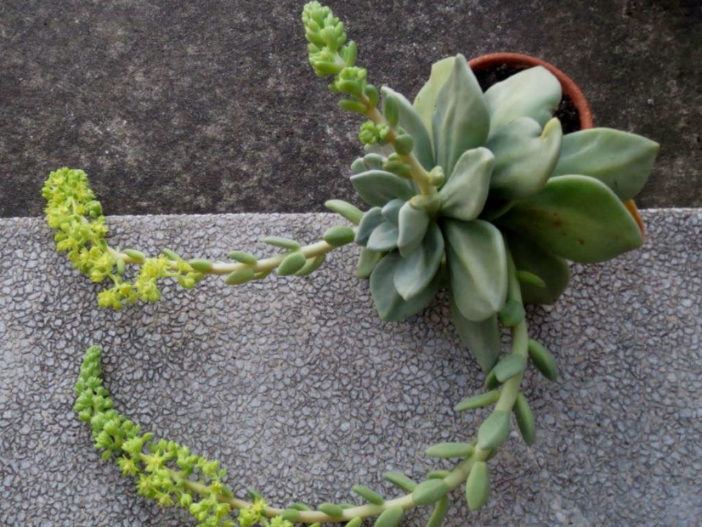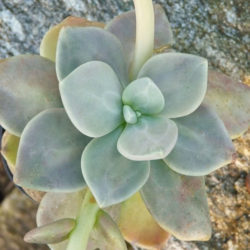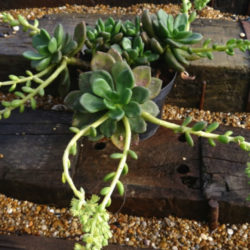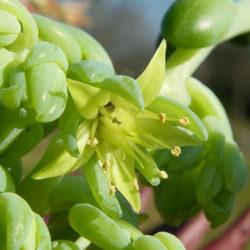Scientific Name
Cremnophila nutans Rose
Synonym(s)
Sedum cremnophila, Sedum nutans
Scientific Classification
Family: Crassulaceae
Subfamily: Sempervivoideae
Tribe: Sedeae
Genus: Cremnophila
Description
Cremnophila nutans is a small succulent with woody stems topped with a quite compact rosette of highly succulent leaves. It branches sparingly from the base. The stems grow up to 32 inches (80 cm) long and up to 1.1 inches (2.8 cm) in diameter, at first erect, becoming decumbent as they elongate. They are shiny green becoming brown with age. The leaves are dark green or grayish-green and covered with dull wax. They are obovate–spatulate, slightly rounded at the apex, up to 2.8 inches (7 cm) long, and up to 1.2 inches (3 cm) wide.
The flowers are star-shaped, bright yellow, and appear in narrow, up to 6 inches (15 cm) long panicles on erect or pendent, up to 4 inches (10 cm) long) stems with small leaves in summer.
Origin
Cremnophila nutans is native to Mexico. It was discovered by Cyrus Pringle on mossy cliffs in the Sierra de Tepoztlan in Morelos in 1899. In 1903 it was described by Rose as Sedum nutans, and two years later, in 1905, he transferred it to his newly created genus Cremnophila.
Etymology
The specific epithet "nutans (NUT-ans)" means "nodding; signaling, gesturing" and refers to the nodding inflorescence, which it can pass on to its hybrids.

Hardiness
USDA hardiness zone 10a to 11b: from 30 °F (−1.1 °C) to 50 °F (+10 °C).
How to Grow and Care
When growing Sedum, keep in mind that plants need very little attention or care. They will thrive in conditions many other plants thrive in but do just as well in less hospitable areas. They are ideal for that part of your yard that gets too much sun or too little water to grow anything else. A common name for Sedum is Stonecrop because many gardeners joke that only stones need less care and live longer.
Sedum is easily planted. Simply laying the plant on the ground for shorter varieties where you want it to grow is usually enough to start the Sedum plant there. They will send out roots from wherever the stem touches the ground and root itself. If you want to ensure that the plant will start there, you can add very thin soil covering the plant. You can break off one of the stems for taller Sedum varieties and push it into the ground where you want to grow it. The stem will root very easily, and a new plant will be established in a season or two.
See more at How to Grow and Care for Sedum.
Hybrids
- ×Cremneria 'Leisal'
- ×Cremneria 'Rapunzel'
- ×Cremnopetalum 'Fred Wass'
- ×Cremnosedum 'Crocodile'
- ×Cremnosedum 'Little Gem'
Links
- Back to genus Cremnophila
- Succupedia: Browse succulents by Scientific Name, Common Name, Genus, Family, USDA Hardiness Zone, Origin, or cacti by Genus
Photo Gallery
Click on a photo to see a larger version.


